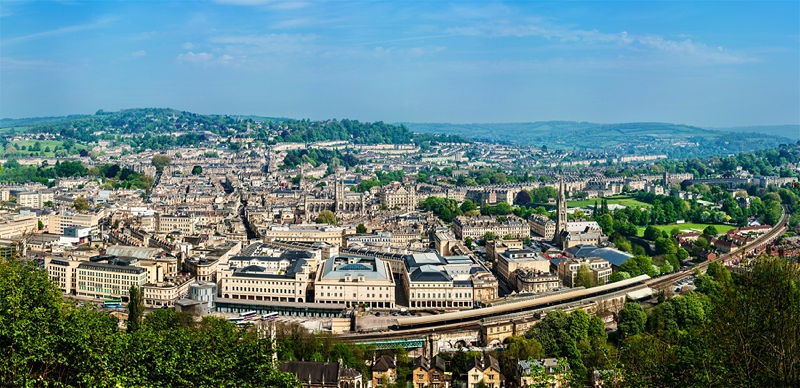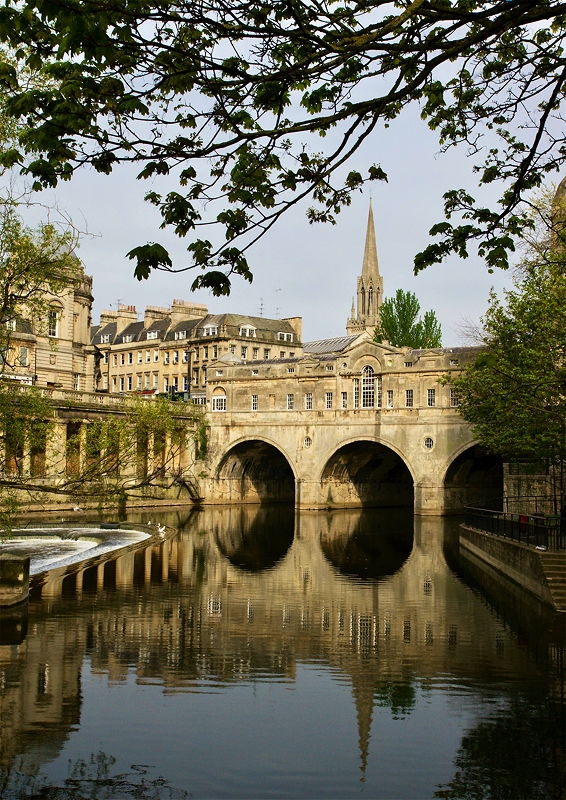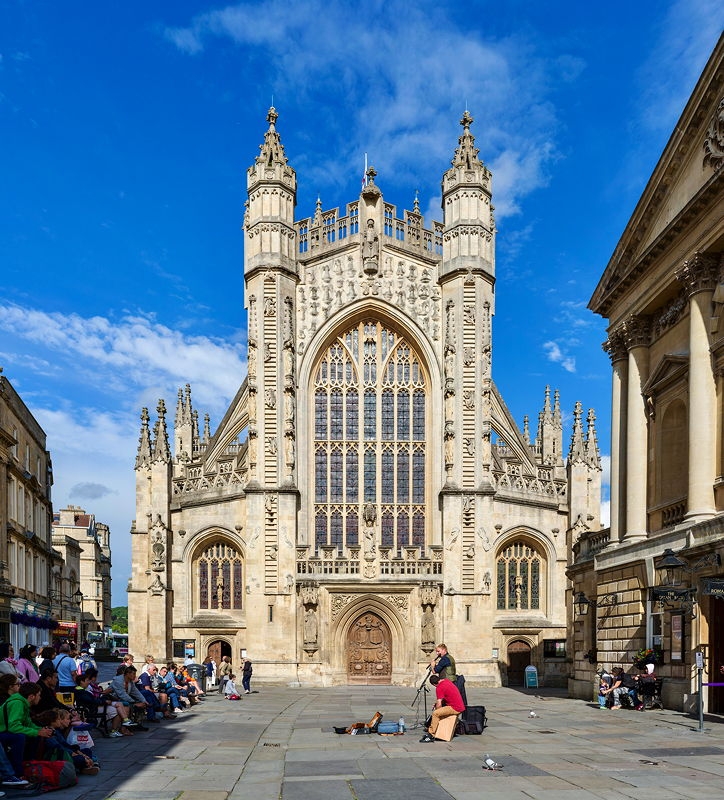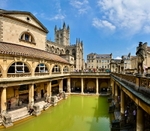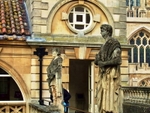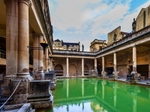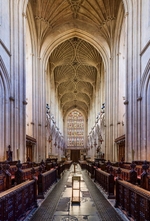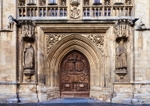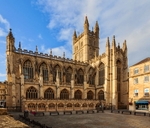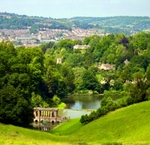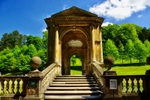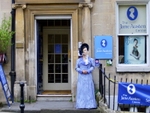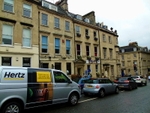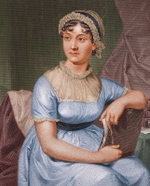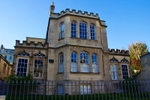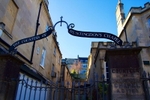1. The Roman Baths
The Bath springs have, every day for thousands of years, produced over a million litres of nutrient rich water at a temperature of 46 degrees Celsius.
Dedicated to Sulis Minerva, a Roman goddess believed to have healing powers, the springs drew visitors from all over the empire.
From around 60-70 AD, a 40-metre high bath complex (complete with caldarium, tepidarium and frigidarium) was built alongside a temple dedicated to Sulis.
Sadly, the site fell into disuse and decay after the fifth century Roman withdrawal from Britain and was not reconstructed until the eighteenth century.
Visitors are now able to marvel at the waters from terraces and courtyards built in the eighteenth and nineteenth centuries (richly decorated with statues of Roman Emperor's and military leaders), and to inspect a large number of Roman artifacts in the site's adjoining museum.
The collection's highlights include a gilt bronze head of Silus, the carved Haruspex stone, 12,000 Roman coins thrown into the waters as offerings to the goddess, and remains of the Roman temple (including a stone carving of a Gorgon's head from the temple's pediment).
Visitors are not permitted to bathe in the waters, though this is permitted at the nearby Thermae Bath Spa.
where? The Roman Baths, Abbey Church Yard, Bath BA1 1LZ. The Baths are found in the centre of Bath, which is 160 kms to the west of London and 10 kms to the east of Bristol.
when? Open all year round (except 25 and 26 Dec), from 9 am (or 9.30 am in winter) to between 5 pm (in winter) and 9 pm (in high summer).
£$€¥For weekday tickets, Adults: £16; Concessions: £14.50; Children: £8.50; The price is slightly higher on weekends. There is a discount when booking online.
2. Bath Abbey
This Anglican church is one of the most impressive architectural gems of the city.
First built in the 7th century, the Abbey Church of Saint Peter & Saint Paul, or Bath Abbey, has had a long and prevalent history.
As with most historic churches in Europe, the Abbey has been built upon, changed, and restored several times. Its current facade is recognized for its architectural merit, and thousands of visitors of all nationalities and faiths visit every year to bask in its quiet and seemingly ephemeral beauty.
Besides its beauty, the church has several war memorials and a Heritage Museum located in the vaults. Due to its historical importance, it is one of the most iconic landmarks in the city.
where? Because of its size, Bath is easily walkable, meaning that you could probably walk to the Abbey from most points of the city centre. If public transportation is more convenient, get off on either Guildhall or Rebecca Fountain stations.
when? Except for certain days listed on its website, the Abbey is open on Mondays from 9:30-17:30, Tuesdays through Fridays from 9:00-17:30, Saturdays from 9:00-18:00, and Sundays from 13:00-14:30 and 16:30-17:30.
£$€¥ There is no cost for entering the church. However, there is a suggested donation of $5-$12 for visitors who wish to help with the upkeep of the landmark.
3. No. 1 Royal Crescent
One of the most fashionable residencies in Bath, now a museum for all to enjoy.
From 1767 to 1776 John Wood the Younger built the elegant Royal Crescent. This collection of 30 houses were amongst the most coveted in the era, and hosted members of the novelty as well as royals. The crescent is a symbol of Georgian high society life, and the most celebrated architectural landmark in Bath.
Most of the apartments lost some of their opulent splendour, and are now divided into apartments. However, No.1 Royal Crescent, which was partially owned by Wood himself, was given to the city and turned into a museum.
Remodelled using 18th century materials and decorated in period style, it is absolutely breathtaking. Though the original design of the house was changed by some of its owners, it is quite similar to what it was at the height of its grandeur. Costumed guides take visitors around the house, giving a glimpse of what life would have been like at the time.
where? The museum is a mere 10 minute walk from the Tourist Information Centre. The nearest bus stops are Nile Street and Alfred Street.
when? The museum is closed for part of the winter. This year, it will be open from February 4th to December 17th. Hours of admission are Mondays from 12:00-17:30, and Tuesdays to Sundays from 10:30-17:30.
£$€¥ The full price of admission for adults is £10.90. Seniors, students, and groups pay £9.80, and children £5.40. Families of two adults and up to four children can buy a bundle for £27.20, and carers of disabled visitors are admitted for free. Additionally, you can buy a joint ticket with entrance to the Museum of Bath Architecture for £16 for adults, £8 for children, £40 for families, and £14.40 concessions.
4. Prior Park Gardens
A landscape garden designed in part by the poet Alexander Pope.
Adjacent to the beautiful Prior Park estate, is one of England’s most beautiful landscape gardens. Verdant hills roll around cascading lakes as animals like birds and deer enjoy the cover of the trees. The gardens are said to have some of the best views of Bath, and it is known for its palladian bridge, of which there are only four in the world.
This is an attraction that every kind of tourist enjoys. From solo travelers who enjoy reading in the grass, to families that find it the perfect playground, to honeymooners who rejoice on the views, it is decidedly one of the city’s most popular spots. Nature lovers enjoy taking the Bath skyline stroll, a 6 mile trail of pure beauty.
where? The gardens are located on Ralph Allen Drive. Bus 1 stops nearby once every hour.
when? As with most outdoor activities, visiting the park is most pleasant when the weather is mild and sunny. However, the views make a visit to it worth it even in the winter. The gardens are open from February to October everyday from 10:00 to 17:30, and from November to January on weekends only from 10:00-16:00.
£$€¥ To get into the park, the admission is £7.50 for adults and $3.75 for children. Because the park is now owned by the National Trust, its members can enjoy it free of charge.
5. Jane Austen Centre
This tribute to one of England’s most celebrated writers is a must-see for anyone interested in history and literature.
With beloved novels like Pride and Prejudice and Persuasion (which takes place in Bath), Jane Austen is recognized and celebrated around the world.
Taking two long holidays in the city, and calling it home from 1801 to 1805, she spend more than five collective years in Bath. This historical house details Austen’s time in the city, and the impact that her time here had on her life and her writing.
The house is a fun and educational tour to the past, with guides dressed in period costume. Those wishing to get a sense of what social life was like during the Regency can sit down and enjoy some pastries and refreshments in the tea room.
Fans—both veteran and newly converted—can also spend some time buying original souvenirs at the centre’s gift shop.
where? The Jane Austen Centre is located at 40 Gay Street. The closest bus station is Queen Square.
when? Opening times for the centre vary by seasons. From November to March, it is open Sundays to Fridays from 10:00-16:00, and Saturdays from 9:45-17:30. From April to October, it is open every day from 9:45 to 17:30, and from July to August it opens 9:30-18:00. The hours for the gift shop are the same.
£$€¥ The full price of admission for adults is £12, children: £5.20. Seniors and students get a discount of £9.40 respectively. Families consisting of two adults and up to four children can get a bundle deal of £28.
6. Museum of Bath Architecture
Tracing the story of Bath, from small town to cultural epicentre.
Once a small provincial town, Bath changed drastically during the 18th century, when it became one of the most famed Georgian cities. The city continues to be a wonderful live display of the architecture of this era, and boasts a unique urban beauty because of it.
The Museum of Bath Architecture is a unique collection of models, maps, paintings, and displays that showcase some of the most interesting structures in the city. It is housed at the Countess of Huntingdon's Chapel and continuously has new exhibitions.
The museum’s gem is a 1:500 scale model of Bath, which allows you to appreciate the city from a bird’s eye view.
where? The museum is located 10 minutes away from No 1. Royal Crescent. The closest bus station is the Alfred Street stop.
when? The museum closes for the winter, opening from mid-February to November on Tuesdays through Fridays from 13:00-17:00, and on Saturdays and Sundays from 10:00-17:00.
£$€¥ For a single ticket, adults pay £6.90, seniors and students pay £6.20. Children from 6 to 16 years old are admitted for £3.50, but any child under the age of 6 gets in for free. Families of two adults and up to four children can buy a bundle deal for £17.30. Additionally, you can buy a joint ticket with admission to No.1 Royal Crescent that is £16 for adults, £8 for children, and £40 for families.
